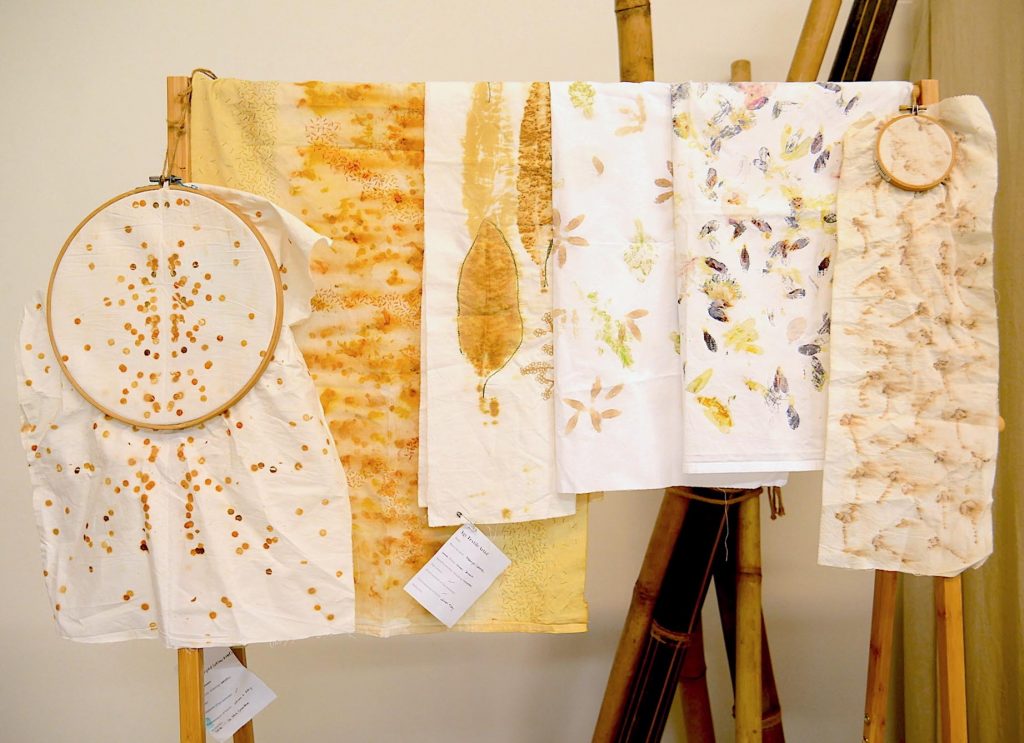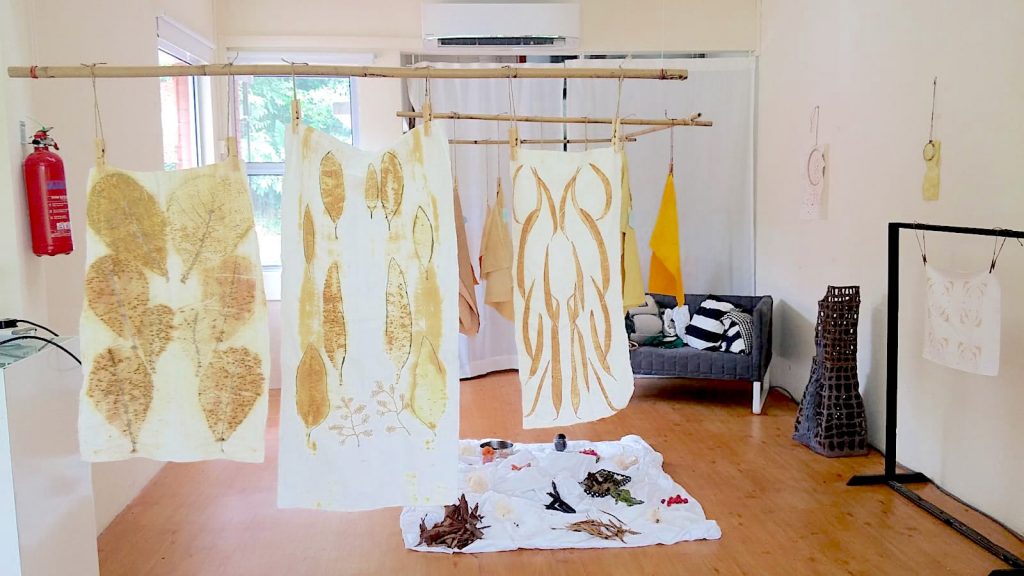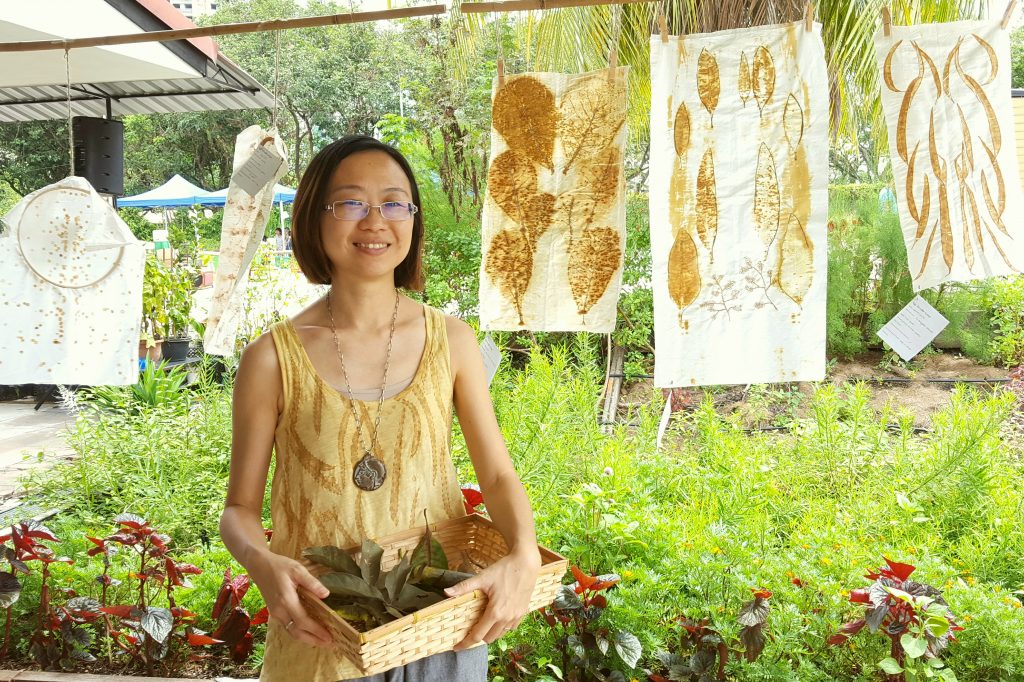Agatha Lee, or Agy, for short, is a long-time environmental advocate who raises awareness of environmental sustainability through her work with textiles. Formerly from Hong Kong, she has been living with her family in Singapore for almost two decades now. She spent half of that time here at the National Environmental Agency before finding her true calling in sustainable fashion, starting with an informative blog on repairing and upcycling clothing, and then co-founding Connected Threads Asia, which runs the local Fashion Revolution Day annually. She eventually moved on to focus on personal artistic projects.
After spending many years honing her craft, Agy developed into an artist, using natural materials and discarded fabrics to create wearable fashion or art pieces, always remaining true to her sustainability roots. She now goes by the name Agy Textile Artist. These days she also busies herself with The Green Collective, a gathering of local eco lifestyle brands in one place – offering retail, co-working office space and workshops.
I’ve known Agy for some years now in the environmental sector, but it was only last year that we began collaborating on workshops, mainly beeswax wrap classes. I’ve always admired the work she does and I love her refashioned pieces, especially her latest wardrobe addition – espadrilles made with fabric scraps. Agy is very creative indeed!
Apart from natural dyeing, she specialises in free motion embroidery, a technique she has used to create artwork from her Nature in Stitches series, and Ocean series, the latter being a collaboration with another artist, Arana Kennedy. Some of this work is documented on her YouTube page, along with other artistic endeavours such as various mending techniques, the natural dyeing process, as well as hand embroidery, so be sure to check it out!
I spent some time with Agy and created my first Garden Stories video on YouTube. Here’s my interview with her.
1. When did you discover your love for working with plants?
I enjoy working with plants and experimenting with their colours. I realised it when I started to explore the parks in my neighbourhood two years ago when I needed to slow down in life. As I reconnected with nature, I started to notice their different textures and how their beauty could be translated into stitches and colour in textiles. There are so many plants in Singapore, and I have to admit I have only touched the surface.
2. Where do you get your inspiration for your creations from?
Nature! There’s so much inspiration out there, you just have to look! I love observing my surroundings and how the public interacts with it. My first work was a series called Nature in Stitches, where I interpreted the bark of common trees in Singapore using natural dyes and free motion embroidery. I then worked on a collaborative piece called Ocean, which looks at how man’s interference with nature has a negative impact on corals.
3. It’s amazing how you managed to source so many of your materials and ingredients locally, where do you find them?
I work mainly with textiles, but I hate waste so I only use what I already have, or use textile waste. My neighbourhood park and my friends’ gardens are sources for my natural dye materials but rather than pick from the plant directly, I only use plant matter that would have otherwise been disposed of. It does sound limiting but I believe in the power of limitations – it forces you to be creative.
4. I love your naturally dyed fabrics. Is it complicated to dye textiles with natural materials at home? Do you need to invest in a lot of tools to do this?
Is it complicated? There’s a lot of science behind natural dyeing, and there is a lot of reading up, but I think the most important thing to remember is that you need a lot of patience as it is a time-intensive process, and sometimes the colours don’t end up the way you expect it to.
I didn’t invest a lot, in fact, I used an old pot that was used for sterilising baby bottles, and I purchased a secondhand rice cooker. My husband says our freezer looks more like a garden! I actually freeze my materials especially those for my eco prints. For the rest of my dyeing, they have to be used fresh.
5. Last year you did an artist residency at L’Observatoire at Blue House for a month. Tell me about the work you created while you were there?
It was a really exciting month of dyeing with natural materials and I wished it was longer. I found myself in the zone of experimenting and creating without any disruptions (no family, no cat!). It was a wonderful experience as the studio was on a preschool campus. It meant I had the chance to interact with the children and get them to contribute to the project – they brought onion skins, avocado seeds and there was even coffee grounds! I also explored the flora on the school premises – working with limitations! The result of the experiments were exhibited to show how we can rethink nature’s contribution to society in terms of colour.
6. Do you have any advice for those who want to begin learning about textile dyeing?
Be patient. Remember that we are dealing with materials from nature, something that is beyond our control. This means we may not be able to replicate the results over time and space. So just relax and enjoy the process. 😀
To find out more about Agy Textile Artist, find her on Facebook, YouTube and her website, where she journals her projects and shares videos of her projects. She runs regular workshops on natural dyeing and refashioning clothing items, more details here!
All photos are taken by Olivia Choong unless otherwise indicated.










3 Comments
Thank you for such a lovely feature! Love working with you 🙂
Thanks Agy, it was my pleasure, thanks for your time! 🙂
I totally agree with this! This is an excellent way to turn your gardening hobby into something more useful and beneficial to the environment. Thank you Olivia for such a great post and to Agy, I wish you good luck!